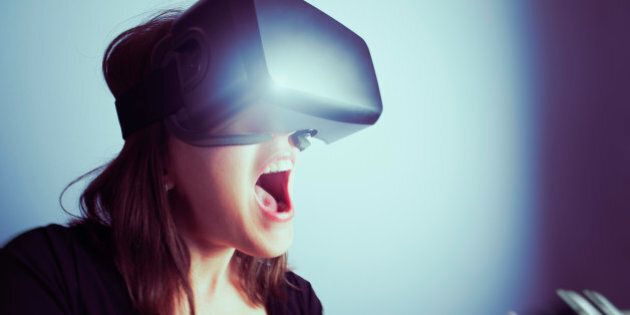
Co-authored by Timothy Schoonhoven
Virtual Reality technology has come a long way since its inception as simple, stereoscopic goggles in 1939. In the last few years, it has transformed into a variety of electrical devices and exploded onto the market as a surprisingly immersive media. Even so, the hardware and software at play are still very new, leaving in gaps in the experience; such as the lack of haptic feedback. In a field where even entrepreneurs are seeking to expand VR beyond its limits, there's a lot that can happen in over two years. Such to the point that it might look like we've stepped into science fiction theater.
Let's take a look at how's everything's trending, and what prototypes are seeking to shake it up.
Currently, the most prominent VR technology within our society is that of the mobile phone headsets. It composes a whopping 98% of VR technology sold in 2016 and has succeeded because of its low cost, and straightforward setup. Buyers only need to obtain the stereoscopic headset, ensure they have a VR-compatible mobile phone (Usually Samsung), and, once setting up their program, can just clip them together. Add in a set of headphones, and tweak the goggles for good measure, and you're ready for a 360 degree, beautiful, in-your-face experience.
The primary drawback of this technology is the extremely limited motion tracking. At most, the system, through a gyroscope, can tell which way you're facing; and with an additional peripheral, can track one of your hands. Otherwise, the viewer remains completely stationary in what can appear to be a breathtaking world. Alongside, there are smaller issues, such as light leaking, resolution (Far away objects are often blurred), and the phone does not have the processing power for more complex VR simulations.
More powerful systems do exist in the market, though the obvious trade-off is a much steeper price tag. Oculus Rift, HTC VIVE, and PlayStation VR are the top powerhouses, and all provide both an immersive and interactive experience. HTC VIVE, for instance, can turn an entire room into a virtual playground for the user to walk and interact in, thanks to its laser capture technology, Lighthouse. Other peripherals, such as Oculus's new Touch, allows you to create varying degrees of hand gestures in the virtual world. This is, however, in exchange for what can go over $800, unlike the mobile phone VR, which costs only between 100-$200.
Beyond this cost, there are still limitations to these systems. PlaystationVR still has the occasional light leak issue; some Oculus games can make you nauseous; VIVE has a lot of equipment to set up. All of them require handheld peripherals to play the VR games, and the most lacking is that of haptic feedback - the ability to feel and touch virtual objects. There's certainly quite some way to go before VR can adequately transport our minds to an entirely different world.
The good news is those prototype technologies aiming to fill in these gaps already exist, and are continually being refined. One major piece that has been around since 2012 is a new form of motion tracking developed by Leap Motion. The device itself is small enough that it can be fitted striated into a VR headset itself, unlike other types of body tracking. This leaves the user's hands and arms completely free, which is exactly what the devices is meant to track. Utilizing a series of small camera's and infrared LEDs, it can accurately map the viewer's hand with near-zero latency. This makes movement in VR very responsive, and with some proper programming, can provide the user with Minority Report-esque interfaces.
The only major hurdle for Leap is how disorienting it can be to pick up an object without being able to feel it in your hands. Thankfully, this latter problem is also being looked at by other entrepreneurs like Unlimited Hand, and VRGluv. Both have designed prototype peripherals that can not only keep track of hand movements but generate various forms of haptic feedback. The former uses Electric Muscle Stimulation (EMS) to simulate the feedback, while the latter use force sensors, allowing them to provide the view the sensation that's he is actually holding an object.
There's still some way to go for these technologies, but the promising aspect is that they're already out there in the hands of other people. Leap has already partnered with other VR developers and is working with mobile VR headsets the most. Meanwhile, Unlimited Hand's prototype is available for purchase, having already held a Hackathon for it, and VRGluv, having smashed Kickstarter goal within 48 hours, is aiming to ship it's prototyping this month. Although haptic feedback will probably be for the more robust systems, both technologies are looking to liven up the VR scene. Chances are, in about two years, mobile platforms will have a lot more interactive features, and the more powerful platforms will have come one step closer to a Star Trek holodeck. Minus the need for a safety feature.
Follow HuffPost Canada Blogs on Facebook